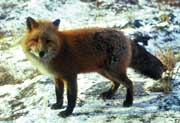Winter Wanderings
By Kathy Reshetiloff

Winter can be quite
a formidable season to enjoy. Many people spend hours holed up
inside their homes, waiting for spring. The warm colors of autumn
have been replaced with the browns, grays and tans of the winter
landscape. The skies are quieter. The migrating raptors, waterfowl
and songbirds have reached their wintering grounds. But a winter
walk can reveal a lovely, albeit different, landscape.
Evergreens, out-dressed most of the year by more flamboyant trees,
feed eyes hungry for color. Chesapeake Bay waters may be dark
and foreboding, but odd driftwood sculptures adorn barren shorelines.
The dry, brown marsh grasses glisten with morning frost, accentuating
the meandering streams that wander through the wetlands. Ducks,
geese and swans forage for food. Crystalline waterlines mark the
daily rhythm of the tides. In this winter starkness, however,
nature reveals itself to us.
Bare trees may look lifeless but, like other living creatures,
they are merely in a dormant state. Twigs hold tightly packed
buds that contain the next spring foliage. The buds of each tree
species are distinctive and, like the bark, can be used as an
identification tool. Trees in winter no longer hide wildlife from
our view. A red-tailed hawk, perched on a bare branch, is easily
spotted.
Naked trees also unveil last year's nests. A clump of leaves in
an oak is the tree-top nest for a gray squirrel. The vacated wasp
nest hangs delicately from the end of a branch like an inverted
top. Bird nests, woven from grass, leaves, twigs, feathers and
string still attached to tree limbs tell much about their inhabitants.
You can identify who your avian neighbors were by the distinct
design of the nest. A loose nest of thorny branches with an inner
layer of moss and grass may be that of a mockingbird. A deeply-cupped,
neatly-lined nest in a thicket probably belonged to a catbird.
The small drooping pouch of soft plant fibers is the handiwork
of the Baltimore oriole. If you see what looks like a small mossy
knot on a tree branch, look again, it may be the tiny nest of
the ruby-throated hummingbird.
Quiet and still as the winter months may be, wildlife still abounds.
Anyone with a passion for feeding birds is treated to a daily
performance as sparrows, chickadees, finches, nuthatches, cardinals,
woodpeckers, crows and blue jays vie for space at a feeding station.
Squirrels busily search for their buried nuts or, if unsuccessful,
merely raid the bird feeder.
Most of the more familiar mammals in this region do not actually
hibernate. Deer, mice, foxes, squirrels and rabbits are active
throughout winter. Beavers, too, are active throughout winter
but will spend most of their time in their lodge. When water freezes,
the beavers feed on bark stashed at the bottom of the pond. Only
the groundhog or woodchuck truly hibernates. Others, like the
chipmunk, raccoon and skunk, go into a semi-hibernating stage.
They may sleep for days or weeks at a time then emerge for food
during an unusually warm winter day.
You may not be aware of local wildlife until a light snow blankets
the ground. Take a quiet walk immediately after the snowfall.
Look down for clues and telltale tracks in the snow. Begin by
looking at familiar tracks. A dog's footprint shows claws; a cat's
does not. This is true for wild canines and felines too. Because
of the way a fox walks, its track forms a single line while a
dog's gait leaves two pairs of tracks. A rabbit's tracks, with
its pair of large hind feet and smaller fore feet, are distinctive
and easily identified.
A field guide on animal tracks is helpful to both the novice and
experienced tracker. By carefully studying tracks you can identify
the animal that made them and what direction it went. Tracking,
however, also includes trying to deduce why this animal was moving
and what may have occurred during its journey. Soon you will discover
that there is indeed an abundance of winter activity. Your exploration
will lead you to questions which will lead you to more exploration.
So when the winter blues bring you down and cabin fever abounds,
look to the outdoors for a new experience. Quietly wander alone
and observe. Look up, down and inward. The winter air is silent,
snow muffles sounds. Listen hard for the rustling of birds and
other wildlife seeking food and cover. Listen as the trees sway
and groan in the wind. Train your eyes to see the beautiful patterns
created by icicles, cracks on a frozen pond and tracks in the
snow. When you finally feel like you belong in this picture, you
will enjoy this new found world. The coming of spring won't seem
so far away and maybe it won't even matter.

After 10 years as a biologist, Kathy Reshetiloff now writes on
a variety of topics for the U.S. Fish and Wildlife Service, U.S.
Department of the Interior.
|
Back
|

